Thank you for visiting! By the way… any links on this page that lead to products on Amazon and other stores/partners are affiliate links Aquarium Store Depot earns a commission if you make a purchase.
Ever wondered how to create a stunning aquatic environment featuring the captivating Rainbow Shark? Look no further! We have compiled an extensive guide to help you find the perfect “rainbow shark tank mates” that will create not only a harmonious living space but also an eye-catching spectacle for fish enthusiasts and casual observers alike. So, let’s dive into the world of Rainbow Sharks and discover the ideal companions for these fascinating creatures.
Key Takeaways
- Rainbow Sharks are territorial and aggressive, so choose tank mates carefully.
- A minimum of a 4 foot long tank is required to curb aggression
- Tips on introducing new fish to your Rainbow Shark tank include adding them last, providing hiding spots & closely monitoring behavior.
Understanding Them
The brightly colored Rainbow Sharks, scientifically termed Epalzeorhynchos frenatum, can often be found swimming in the warm rivers of Southeast Asia. They are not related to the saltwater fish and are a completely different scientific family, with most freshwater sharks being a part of the Cyprinidae family.
With their dark blue bodies and dazzling orange or red-black fins, they are a popular addition to aquariums around the world. The albino rainbow shark also stands out with its distinct look from other varieties of this freshwater fish.
It is important for those looking to add these animals into an existing tank that they understand how territorial and aggressive Rainbow Sharks tend to be (especially towards bottom dwellers as well as any similar species present) before introducing them alongside potential tank mates. Understanding what type of food rainbow sharks consume also falls under preparation requirements here too!
Aggression And Territorial Nature
It’s essential to take into account the aggressive nature of Rainbow Sharks when selecting their tank mates, as they are known for claiming dominance over a particular territory in an aquarium. To reduce the likelihood of aggression towards other fish that might have similar physical traits or occupy adjacent areas within the same environment, select non-aggressive species which don’t possess long fins and substantial tails.

These fish should either be larger than the shark, be able to stand up for themselves, school in large numbers, or be very fast. This will keep tension between inhabitants at bay and maintain peace across all corners of your underwater oasis.
Ideal Tank Size And Parameters
When it comes to rainbow shark care, they are relatively hardy fish. In order to cohabitate peacefully with their tank mates, a minimum of a 50 gallon fish tank is required for the aquarium size, with the tank length being at minimum 4 feet. Anything smaller will result in an aggressive rainbow shark that will harass your peaceful fish.
Rainbow sharks live with pH from 6.0 – 8.0, hardness levels of 3-14 dKH and nitrate levels no higher than 40ppm. Zero ammonia and nitrite must be maintained in order for these fish to thrive optimally.
Decorations like rocks, driftwood & caves will create plenty of hiding spots, which allow them to set up personal boundaries within the tank comfortably, thus giving them peace of mind when living in harmony with its occupants.
Top 15 Rainbow Shark Tank Mates
So let’s take a look at the top 15 shark tank mates compatible with these striking fish! Each aquarium fish featured offers its own unique features that complement your shark.
1. Tiger Barbs
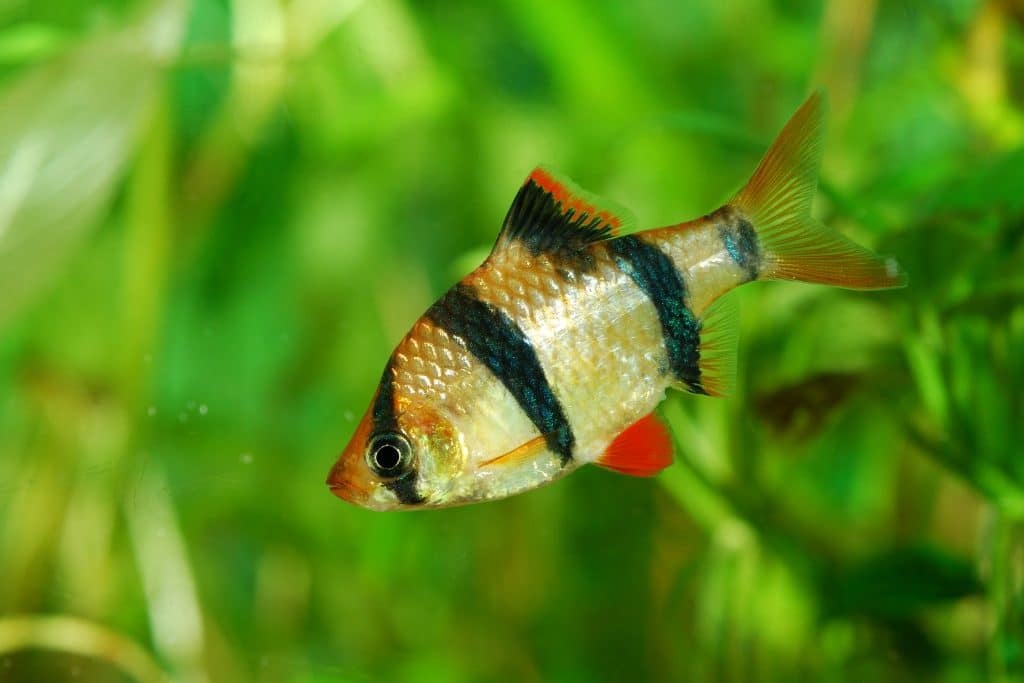
- Scientific Name: Puntius tetrazona, Barbus tetrazona, Capoeta sumatraus, Barbodes tetrazona, and Capoeta tetrazona
- Life Span: 5 to 7 years
- Adult Size – 4 inches
- Water Temperature: 73°F to 86°F
- Minimum tank size: 20 gallons
- Care Level: Easy
- Diet: Omnivore
- Origin: Southeast asia
- Swimming Level: Mid
Tiger Barbs can provide a vibrant addition to aquariums when kept in schools of 6 or more, as long as their habitat provides enough room for them to swim. With their small size and quick movements, these active fish are able to avoid confrontation with Rainbow Sharks.
These omnivorous fish need both live food (e.g., worms) and processed food items like flakes, pellets, etc. One also needs to be careful not to introduce any passive species which may become victims of Tiger barbs’ fin-nipping behavior!
2. Gouramis

- Scientific Name: Trichopodus spp.
- Life Span: 4 to 6 years
- Adult Size: 4 – 7 inches
- Water Temperature: 76°F to 82°F
- Minimum tank size: 30 gallons
- Care Level: Easy to Moderate
- Diet: Omnivore
- Origin: East Asia
- Swimming Level: Top to Mid
Gouramis can peacefully coexist with Rainbow Sharks if carefully chosen in terms of size and demeanor. These fish offer the other tank inhabitants plenty of room to avoid conflicts while swimming around at all levels inside the aquarium.
When deciding on a suitable companion for your rainbow shark, you should consider varieties such as Blue Gourami, Pearl Gourami, or Moonlight Gourami that will help promote harmony within their aquatic home. Make sure the tank is appropriately large enough and decorated accordingly!
3. Congo Tetra
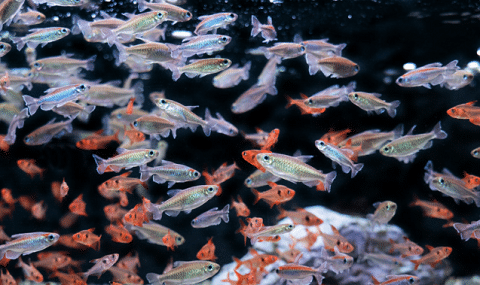
- Scientific Name: Phenacogrammus Interruptus
- Life Span: 3 to 5 years
- Adult Size: 3- 4 inches
- Water Temperature: 73°F to 82°F
- Minimum tank size: 30 gallons
- Care Level: Easy
- Diet: Omnivore
- Origin: Africa
- Swimming Level: Top to Mid
Congo Tetras are social, peaceful creatures and make ideal tank mates for Rainbow Sharks. These spectacular fish benefit from living in schools of 6 or more to avoid any territorial issues with the sharks and they mostly swim around near the middle-to-top part of their environment.
These omnivores consume live, dried or frozen food, so feeding them along side Rainbow Sharks is a hassle free activity, making it easier for you as an aquarist!
4. Rainbowfish
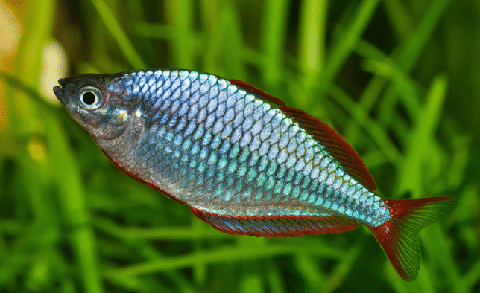
- Scientific Name: Melanotaenia spp.
- Life Span: 5 to 8 years
- Adult Size: 4- 5 inches
- Water Temperature: 72°F to 77°F
- Minimum tank size: 40 gallons
- Care Level: Moderate
- Diet: Omnivore
- Origin: Indonesia (some are from Australia
- Swimming Level: Middle
Rainbowfish possess a combination of bright colors and swift swimming capabilities, enabling them to coexist in the same tank with Rainbow Sharks due to their top-dwelling behavior. Their beautiful coloring and lively movements make for an appealing addition to any aquarium environment.
A popular variety is known as Dwarf Neon Rainbowfish, a small but animated species hailing from Indonesia that needs at least ten or more individuals living harmoniously. They feed off algae, worms, bloodworms, daphnia insects & mosquitoes as well as vegetables such as spinach leaves, cabbage & peas.
5. Bristlenose Pleco

- Scientific Name: Ancistrus Cirrhosus
- Life Span: 5 to 12 years
- Adult Size: 4 to 5 inches
- Water Temperature: 73°F to 80°F
- Minimum tank size: 30 gallons
- Care Level: Easy
- Diet: Herbivore
- Origin: Amazon
- Swimming Level: Bottom
Bristlenose Plecos are usually a calm species and don’t typically display aggression towards other tank mates, even when they reach their mature size. They possess an instantly recognizable bristly nose and eat algae from the bottom of tanks. These fish should be kept in large aquariums alongside Rainbow Sharks to prevent any potential conflicts that may arise due to territorial disputes or lack of hiding spots for either species.
6. Danio Fish

- Scientific Name: Danio spp.
- Life Span: up to 5 years
- Adult Size: 1 – 4 inches
- Water Temperature: 64°F to 75°F
- Minimum tank size: 10 gallons
- Care Level: Easy
- Diet: Omnivore
- Origin: India
- Swimming Level: All
Danio Fish are ideal tankmates for Rainbow Sharks, as they can peacefully inhabit the middle of an aquarium. With their colorful appearance and lifespan up to 5 years, these fish make a great addition to your environment. Their diet is primarily made up of foods such as worms, bloodworms and daphnia. But vegetables like lettuce, zucchini or peas are also welcomed treats! Because Danio’s swim around quickly in tanks, they do not disturb other aquatic life easily, making them excellent rainbow shark companions. They are fast enough to escape any aggression.
Giant and pearl danios are the best choices when it comes to danio fish with a rainbow shark.
7. Severum
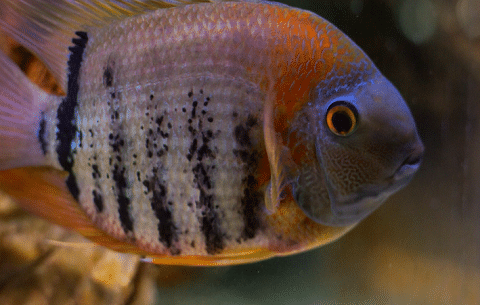
- Scientific Name: Heros severus
- Life Span: 7 to 10 years
- Adult Size: 8 inches
- Water Temperature: 75°F to 84°F
- Minimum tank size: 55 gallon tank
- Care Level: Moderate
- Diet: Omnivore
- Origin: South America
- Swimming Level: Bottom to Mid
A large, peaceful cichlid like a Severum is a perfect addition to an impressively decorated aquarium, as they can easily cohabitate with Rainbow Sharks. Since these species have similar water parameters and temperaments, it’s unlikely that any territorial dispute will arise between them in the same tank.
The vibrant colors on their body really make for quite an interesting sight when contrasted against the dark hues of a Rainbow Shark. Thus creating even more visual appeal within your aquarium! To ensure both fish live harmoniously with each other, remember to give each enough room by having adequate hiding places throughout too.
8. Odessa Barbs
- Scientific Name: Pethia padamya
- Life Span: 3 to 5 years
- Adult Size: 3 inches
- Water Temperature: 70°F to 78°F
- Minimum tank size: 30 gallons
- Care Level: Easy
- Diet: Omnivore
- Origin: Asia
- Swimming Level: Middle dwellers
Odessa Barbs (video source) are a type of schooling fish that can co-exist peacefully with Rainbow Sharks in the same tank when kept in groups and given plenty of room to swim. These calm aquatic creatures make suitable companions for your shark. Caution should be taken not to house them with other species who have extended fins or slower swimming speed as they may become vulnerable targets for nipping. To maintain harmony, it is recommended that at least six members from the same variety are purchased so they retain their social interactions.
9. Black Shirt Tetra
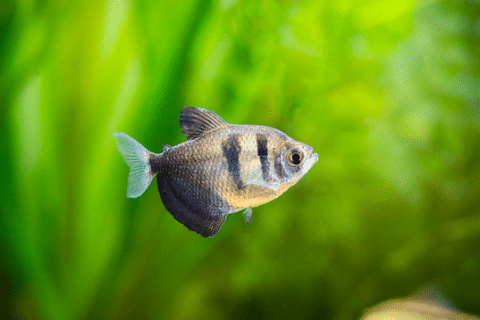
- Scientific Name: Gymnocorymbus ternetzi
- Life Span: 3 to 5 years
- Adult Size: 3 inches
- Water Temperature: 70°F to 82°F
- Minimum tank size: 15 gallons
- Care Level: Easy
- Diet: Omnivore
- Origin: South America
- Swimming Level: Middle dwellers
Black Skirt Tetras are a peaceful, mid-level schooling fish found in South America. These lovely creatures have an eye-catching striped pattern. Their body is colored black with a red or orange stripe running down its back and along the sides of it too. To ensure that both Black Skirt Tetras and Rainbow Sharks can live harmoniously together as tankmates, make sure to provide them adequate room for swimming around in water conditions appropriate for each species. A large school is recommended to curb any nipping tendencies and to provide safety in numbers against the shark.
10. Blue Acara

- Scientific Name: Andinoacara pulcher
- Life Span: 7 to 10 years
- Adult Size: 6 inches
- Water Temperature: 74°F to 82°F
- Minimum tank size: 40 gallons
- Care Level: Moderate
- Diet: Omnivore
- Origin: Hybrid
- Swimming Level: Middle to Bottom
Originating from South America and growing up to 6 inches in length, Blue Acaras are a stunning semi aggressive fish that is from the Cichlid family. Space is the biggest requirement when it comes to housing these fish. A sizeable 4 foot long thank is recommended with plenty of hiding spots. The Acara can stand up for itself, though caution and observation should be made if the Acara breeds as they get aggressive during this time.
11. Scissortail Rasbora
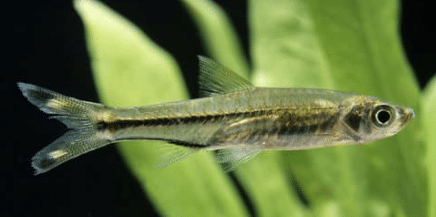
- Scientific Name: Rasbora trilineata
- Life Span: 5 years
- Adult Size: 3.5 inches
- Water Temperature: 73°F to 78°F
- Minimum tank size: 20 gallons
- Care Level: Moderate
- Diet: Omnivore
- Origin: East Asia
- Swimming Level: Middle
Scissortails are lively and energetic creatures that form great tankmates for Rainbow Sharks, as they thrive in larger tanks. These attractive fish love being kept together in groups while swimming freely around the middle section of their homes, far from any territorial disputes with Rainbows.
It is essential to furnish them with an aquarium decorated nicely with rocks and plants since it gives these species places to escape when feeling unsafe or nervous. Schooling numbers should be large with this rasbora to discourage aggressive behavior.
12. Harlequin Rasbora
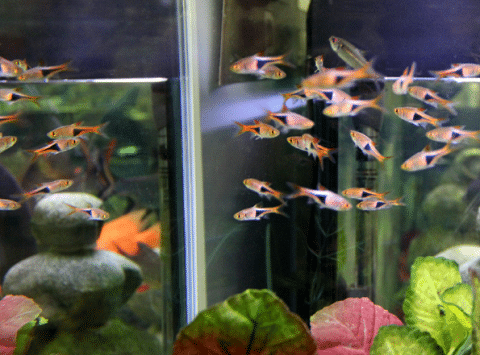
- Scientific Name: Trigonostigma heteromorpha
- Life Span: 5 to 8 years
- Adult Size: 1.75 inches
- Water Temperature: 71°F to 80°F
- Minimum tank size: 10 gallons
- Care Level: Easy
- Diet: Omnivore
- Origin: South Asia
- Swimming Level: Middle
Harlequin Rasboras are a visually striking species of schooling fish that peacefully coexist with Rainbow Sharks in an aquarium full of plants. They largely stay at the top and middle levels, away from more aggressive bottom dwellers like Rainbows.
Being omnivorous, Harlequins eat both live or frozen food as well as dried foods, making mealtime straightforward for their tankmates too. Like the scissortail, they should be kept in large schools with the shark.
13. Cory Catfish

- Scientific Name: Corydoras spp.
- Life Span: 7 to 10 years
- Adult Size: 2 to 3 inches
- Water Temperature: 72°F to 77°F
- Minimum tank size: 10 gallons
- Care Level: Easy
- Diet: Omnivore
- Origin: South America
- Swimming Level: Bottom of tank
Cory Catfish are beautiful creatures who prefer to live in groups at the bottom of tanks. To prevent any conflicts between Corys and Rainbow Sharks, it is vital to have a sizable aquarium with plenty of hiding areas and sandy ground for them both. If kept in large schools, the rainbow shark may chase the catfish, but will usually not attack the fish.
14. Hillstream Loach

- Scientific Name: Sewellia lineolata
- Life Span: 5 to 10 years
- Adult Size: 2.0 to 2.5 inches
- Water Temperature: 64°F to 80°F
- Minimum tank size: 20 gallons
- Care Level: Moderate
- Diet: Omnivore
- Origin: Vietnam
- Swimming Level: Bottom
Hillstream Loaches are fascinating bottom-dwelling fish with an unusual manta ray shape and attractive colorings, making them a great choice for any aquarium. It’s important to provide plenty of cover spots as well as swift water currents when they’re kept in the same tank with Rainbow Sharks since this is how these creatures exist naturally. It is possible that the rainbow shark will attempt to chase the loach away, but these fish are fast enough to not be bullied by their territorial behavior as long as the tank is large enough. Plan on also purchasing a group of them as they prefer safety in numbers.
15. Hemichormis Exsul
- Scientific Name: Rubricatochromis exsul
- Life Span: 5 to 10 years
- Adult Size: 4 inches
- Water Temperature: 73°F to 80°F
- Minimum tank size: 29 gallons
- Care Level: Moderate
- Diet: Omnivore
- Origin: Kenya
- Swimming Level: Mid to Top
Hemichromis Exsul (video source), also known as Turkana Jewel Cichlid, are peaceful cichlid species native to Africa. In larger tanks with plenty of hiding spots, they can make attractive and interesting tankmates for Rainbow Sharks. They are not as aggressive as Jewel Cichlids, yet will still stand up for themselves if your shark tries to bully them.
The best chance of success with these fish is space. Have a 4 foot long space to decrease the chance of territorial conflicts between the two species.
Iffy Choices

In order to keep fish species compatible with Rainbow Sharks, it is important for aquarists to closely monitor their tanks. While the fish we mentioned on our list should do fine with Rainbow sharks, here are a list of fish that are often considered, but may be bad choices:
- Angelfish – Can work – 60/40 chance
- African Cichlids – Africans will usually bully the redtail.
- Green Terrors – Green terror may bully the shark
- Oscars – Very dependent on the the individual temperament of your Oscar
Beginners should research each of these species thoroughly before attempting them alongside sharks. As always, when dealing with a new setup or tank inhabitants, there could be potential disputes over territory, so caution should always be exercised.
Bad Choices
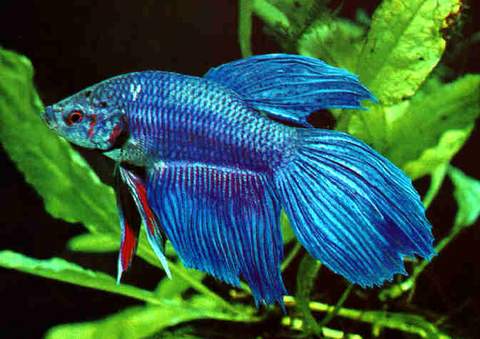
Some popular species of fish often get considered with Rainbow sharks. Here a few that are bad choices and shouldn’t be housed together:
- Betta Fish – will get bullied
- Dwarf Shrimp – will get eaten
- Discus fish – Discus are too peaceful for them. Though a maybe in very large tanks
Tips For Introduction
It is important to adhere to certain steps when adding new aquarium companions for Rainbow Sharks. You should add the shark at last, provide hiding spaces, and minimize spaces issues that can lead to territorial clashes between fish.
You can also opt to introduce the fish in a breeder box to see how fish interaction with them the first few days of interaction. Keeping an eye on each species’ behavior ensures no bullying from your sharks takes place in order for them both and their tank mates to coexist peacefully in a community tank setting.
Frequently Asked Questions
What can a rainbow shark live with?
Rainbow Sharks should be kept away from any smaller fish because they can become the dominant species. They are an excellent tankmate for larger freshwater fish organisms such as Danios, Gouramis, Rasboras and Rainbowfish plus Barbs, Loaches and Plecos. Some bigger shrimp varieties make great companions too!
What fish can I have with my rainbow shark?
Keeping rainbow sharks in your aquarium with other fish, such as small tetras, rasboras and larger cichlids like Neolamprologus Pulcher (a dwarf African Cichlid), is possible provided that they can protect themselves. To ensure a healthy environment for all tank mates it is important to provide adequate hiding spots and take measures to maintain the water quality in order to prevent aggressive behavior from the shark. The other species must be able to choose where or when they flee if feeling threatened by their neighbor.
What fish cannot live with rainbow shark?
Rainbow sharks are a semi-aggressive species and should not be housed with long finned fish such as angelfish or smaller breeds. Tankmates that work well for them include Danios, Gouramis, Rasboras, Rainbowfish, Apistogramma Dwarf Cichlids, Green Neon Tetras African Cichlids Synodontis Catfishes & Bichirs. All these mentioned tank mates can coexist harmoniously in an aquarium along with rainbow sharks.
Are rainbow shark fish aggressive?
Rainbow sharks, although small in size and not a risk to their owners, can be quite aggressive when other fish are around. It is essential that they are monitored carefully after adding them into an aquarium setting so as to make sure no additional creatures get targeted by these semi-aggressive animals.
It’s important for the tank owner to stay alert regarding any hostile behaviors from rainbow sharks toward their fellow aquatic inhabitants. Otherwise, it could lead to bad outcomes eventually!
What is the ideal tank size for Rainbow Sharks?
A tank of 50 gallons or more is a great idea for Rainbow Sharks, giving them ample space to move around. This offers plenty of swimming room and also has enough space in the aquarium to include any other types of fish which may be present. A large size container like this allows these species their natural aquatic movements while promoting healthy behaviors all at once.
Closing Thoughts
To sum up, finding tank mates that will fit well in a Rainbow Shark aquarium can be an enjoyable experience. It is important to know about the habits of these fish and pick suitable candidates for their company to create a lovely atmosphere with plentiful harmony inside the community tank.
Have you tried to keep these fish in your aquarium? Let us know your experience in the comments below. See you next time fishkeepers!
- About the Author
- Latest Posts
I’m thrilled that you found Aquarium Store Depot! Here you’ll find information on fish, aquariums, and all things aquatics related. I’m a hobbyist (being doing this since I was 11) and here to help other hobbyists thrive with their aquariums! I adhere to a high quality Editorial Process and Review products with real life field usage and practical analysis.





